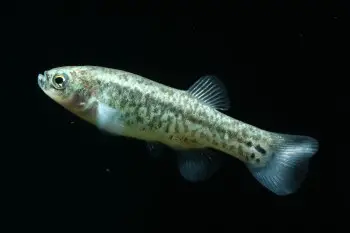Aphanius sp. ‘Namak’ given official name
The undescribed killifish commonly referred to as Aphanius sp. ‘Namak’ or ‘Namak River’ in the aquarium hobby has been formally named.
Aphanius arakensis Teimori, Esmaeili, Gholami, Zarei, and Reisenbacher 2012 has been available in the aquarium hobby for several years already although prior to description some regarded it as potentially conspecific with the congener A. sophiae (Heckel, 1847). The latter is now considered endemic to the endorheic Kor River basin near Shiraz in Fars province, however, while A. arakensis is found only in the Namak Lake system, another endorheic basin located much further north at the borders of Qom, Esfahan, and Semnan provinces.
An endorheic basin is a closed hydrological system with no outflow to an ocean or larger river from which water can only leave via evaporation or seepage. These most often occur in inland, arid regions with relatively low rainfall, and frequently comprise a series of minor springs or rivers which converge at the bottom of the basin to form a salt lake.
Namak is typical in this respect and although the lake itself has a surface area of around 1800 km² very little of this contains permanent water and no fishes are able to survive there. A. arakensis is instead restricted to a series of small springs around 150 km away, near the city of Arak. The type locality, a small, shallow pool fed by a natural spring, is described as ‘in a bad condition due to anthropogenic pollution’.

Females have relatively large dark blotches on the body when compared with related species. © Barbara Nicca.
A. arakensis can be told apart from other Aphanius spp. found in Iran by the following combination of characters: 10–12 anal fin rays; 28–32 lateral line scales; 10–13 caudal peduncle scales; 8–10 gill rakers; 12–19, commonly 11–13, clearly-defined vertical flank bars in males; prominent flank pigmentation with relatively large dark blotches in females; otolith with a short but high antirostrum and wide excisura, and a ventral rim with some small, drop-like processes; 19 molecular apomorphies (17 transitions, two transversions) in the cytochrome b gene.
For further information please refer to the full, open access paper: Teimori, A, H. R. Esmaeili, Z. Gholami, N. Zarei, and B. Reisenbacher. 2012. Aphanius arakensis, a new species of tooth-carp (Actinopterygii, Cyprinodontidae) from the endorheic Namak Lake basin in Iran. Zookeys 215: 55-76
Category: Ichthyology, New Species, News | Tags: Aphanius, Iran, killifish, new species | Comment »



Product reviewers wanted
Are you still looking for product reviewers?
19th Dec 2024
Product reviewers wanted
Hey! Interesting article!
17th Dec 2024
Site improvements
Got it! Thanks for the update. It's good to know that Seriously Fish is working on improving the site's performance and addressing the email and forum...
21st Nov 2024
Responsive design
Nice
13th Nov 2024
Responsive design
it is a complete malfunctioning horror on iphone and ipad.
10th Nov 2024